An Evolutionary Game Perspective for Promoting Utilization of Crop Straw as Energy: A Case Study in Guangdong
Abstract
1. Introduction
2. Research Methodology
2.1. Model Assumptions
2.2. Model Interaction and Payment Matrix
3. Evolutionary Game Analysis
3.1. Replicated Dynamic Equations and Evolutionary Game Path
- (1)
- Farmers
- (2)
- Biomass Enterprises
- (3)
- Government
3.2. Stability Analysis of Equilibrium Points
4. Numerical Simulations
4.1. Simulation Results of Parameter Changes
4.1.1. Small-Scale Market-Oriented Equilibrium E2 (1, 0, 0)
4.1.2. Large-Scale Market-Oriented Equilibrium E5 (1, 1, 0)
4.1.3. Small-Scale and Non-Market-Oriented Equilibrium E6 (1, 0, 1)
4.1.4. Large-Scale and Non-Market-Oriented Equilibrium E8 (1, 1, 1)
4.2. Simulation Results of Straw Energy Utilization Improvement Scenarios in Guangdong Province
4.2.1. Survey Data and Parameter Selection
4.2.2. Case Simulation
5. Conclusions
Author Contributions
Funding
Institutional Review Board Statement
Informed Consent Statement
Data Availability Statement
Conflicts of Interest
References
- Zhang, Q.; Zhou, D.; Fang, X. Analysis on the Policies of Biomass Power Generation in China. Renew. Sustain. Energy Rev. 2014, 32, 926–935. [Google Scholar] [CrossRef]
- Malek, A.; Hasanuzzaman, M.; Rahim, N.A.; Turki, Y.A.A. Techno-Economic Analysis and Environmental Impact Assessment of a 10 MW Biomass-Based Power Plant in Malaysia. J. Clean. Prod. 2017, 141, 502–513. [Google Scholar] [CrossRef]
- Qiu, H.; Sun, L.; Xue, X.; Bai, J. Potentials of Crop Residues for Commercial Energy Production in China: A Geographic and Economic Analysis. Biomass Bioenerg. 2014, 64, 110–123. [Google Scholar] [CrossRef]
- Qian, B.; Shao, C.; Yang, F. Spatial Suitability Evaluation of the Conversion and Utilization of Crop Straw Resources in China. Environ. Impact Assess. Rev. 2024, 105, 107438. [Google Scholar] [CrossRef]
- Jia, Y. The Development Status and Future Measures of Agricultural Circular Economy in China. Macroecon. Manag. 2022, 50–56+81. [Google Scholar] [CrossRef]
- Wu, Y.; Li, L.; Xu, R.; Chen, K.; Hu, Y.; Lin, X. Risk Assessment in Straw-Based Power Generation Public-Private Partnership Projects in China: A Fuzzy Synthetic Evaluation Analysis. J. Clean. Prod. 2017, 161, 977–990. [Google Scholar] [CrossRef]
- Zeng, Y.; Cao, Y.; Qiao, X.; Seyler, B.C.; Tang, Y. Air Pollution Reduction in China: Recent Success but Great Challenge for the Future. Sci. Total Environ. 2019, 663, 329–337. [Google Scholar] [CrossRef] [PubMed]
- Yu, H.; Yang, Y.; Dong, S. A System Dynamics Model to Assess the Effectiveness of Governmental Support Policies for Renewable Electricity. Sustainabilty 2019, 11, 3426. [Google Scholar] [CrossRef]
- Yu, Y. Low-Carbon Technology Calls for Comprehensive Electricity-Market Redesign. Front. Eng. Manag. 2019, 6, 128–130. [Google Scholar] [CrossRef]
- Liu, P.; Li, A.; Wang, Y.; Cai, Q.; Yu, H.; Li, Y.; Peng, H.; Li, Q.; Wang, Y.; Wei, X.; et al. Distinct Miscanthus Lignocellulose Improves Fungus Secreting Cellulases and Xylanases for Consistently Enhanced Biomass Saccharification of Diverse Bioenergy Crops. Renew. Energy 2021, 174, 799–809. [Google Scholar] [CrossRef]
- DeYong, G.D.; Pun, H. Is Dishonesty the Best Policy? Supplier Behavior in a Multi-Tier Supply Chain. Int. J. Prod. Econ. 2015, 170, 1–13. [Google Scholar] [CrossRef]
- Fang, Y.; Zhang, S.; Zhou, Z.; Shi, W.; Xie, G. Sustainable Development in China: Valuation of Bioenergy Potential and CO2 Reduction from Crop Straw. Appl. Energy 2022, 322, 119439. [Google Scholar] [CrossRef]
- Liu, W.; Long, S.; Wei, S.; Xie, D.; Wang, J.; Liu, X. Smart Logistics Ecological Cooperation with Data Sharingand Platform Empowerment: An Examination with Evolutionary Game Model. Int. J. Prod. Res. 2021, 60, 4295–4315. [Google Scholar] [CrossRef]
- Guajardo, M.; Ronngvist, M.; Flisberg, P.; Frisk, M. Collaborative Transportation with Overlapping Coalitions. Eur. J. Oper. Res. 2018, 271, 238–249. [Google Scholar] [CrossRef]
- Bernier-Oviedo, D.J.; Duarte, A.E.; Sánchez, O.J. Evaluation and Design of Supply Chains for Bioenergy Production. Energies 2025, 18, 1958. [Google Scholar] [CrossRef]
- Zhang, L.; Wu, B. Farmer Innovation System and Government Intervention: An Empirical Study of Straw Utilisation Technology Development and Diffusion in China. J. Clean. Prod. 2018, 188, 698–707. [Google Scholar] [CrossRef]
- Zhang, L.; Guo, Q. Air Polutant Emision Mechanism, Spatio-Temporal Patterns and Emission Reduction Strategies of Resource-Oriented Utilization of Crop Straw: A Literature Review. Southwest Univ. (Nat. Sci. Ed.) 2020, 42, 143–153. [Google Scholar]
- Allameh, G.; Saidi-Mehrabad, M. A Game Theory Approach in Long-Term Strategy Selection in Biofuel Supply Chain. Environ. Prog. Sustain. Energy 2019, 38, 13122. [Google Scholar] [CrossRef]
- Friedman, D. Evolutionary Games in Economics. Econometrica 1991, 59, 637–666. [Google Scholar] [CrossRef]
- Su, X. Bounded Rationality in Newsstand Models. Manuf. Serv. Oper. Manag. 2008, 10, 563–691. [Google Scholar] [CrossRef]
- Chen, H.; Wang, J.; Miao, Y. Evolutionary Game Analysis on the Selection of Green and Low Carbon Innovation Between Manufacturing Enterprises. Alex. Eng. J. 2021, 60, 2139–2147. [Google Scholar] [CrossRef]
- Jiang, Z.Z.; Kong, G.; Zhang, Y. Making the Most of Your Regret: Workers’Relocation Decisions in On-Demand Platforms. Manuf. Serv. Oper. Manag. 2021, 23, 695–713. [Google Scholar] [CrossRef]
- He, N.; Jiang, Z.Z.; Huang, S.; Li, K. Evolutionary Game Analysis for Government Regulations in a Straw-based Bioenergy Supply Chain. Int. J. Prod. Res. 2023, 61, 6093–6114. [Google Scholar] [CrossRef]
- Bai, W.; Zhang, L.; Zhou, Z.; Yan, L. Exploring the Dilemma of Straw Economy in China: An Analysis Based on Tripartite Evolutionary Game Model. Energy Econ. 2024, 139, 107913. [Google Scholar] [CrossRef]
- Wang, L.; Wang, Z.; Tahir, N.; Wang, H.; Li, J.; Xu, G. Study of Synergetic Development in Straw Power Supply Chain: Straw Price and Government Subsidy as Incentive. Energy Policy 2020, 146, 111788. [Google Scholar] [CrossRef]
- Zhang, X.; Luo, K.; Tan, Q. A Game Theory Analysis of China’s Agri-Biomass-Based Power Generation Supply Chain: A Co-opetition Strategy. Energy Procedia 2017, 105, 168–173. [Google Scholar] [CrossRef]
- Wen, W.; Zhou, P. Impacts of Regional Governmental Incentives on the Straw Power Industry in China: A Game-Theoretic Analysis. J. Clean. Prod. 2018, 203, 1095–1105. [Google Scholar] [CrossRef]
- Wen, W.; Zhang, Q. A Design of Straw Acquisition Mode for China’s Straw Power Plant Based on Supply Chain Coordination. Renew. Energy 2015, 76, 369–374. [Google Scholar] [CrossRef]
- Wang, L.; Watanabe, T. A Stackelberg Game Theoretic Analysis of Incentive Effects under Perceived Risk for China’s Straw-Based Power Plant Supply Chain. Energies 2016, 9, 455. [Google Scholar] [CrossRef]
- Wang, Z.; Hou, T.; Wang, Z. Revenue Coordination of Straw Powergeneration Supply Chain under Carbon Trading Environment. Waste Biomass Valor. 2023, 14, 1769–1785. [Google Scholar] [CrossRef]
- Yin, Q.; Wang, Q.; Du, M.; Wang, F.; Sun, W.; Chen, L.; Hong, T. Promoting the Resource Utilization of Agricultural Wastes in China with Public-Private-Partnership Mode: An Evolutionary Game Perspective. J. Clean. Prod. 2024, 434, 140206. [Google Scholar] [CrossRef]
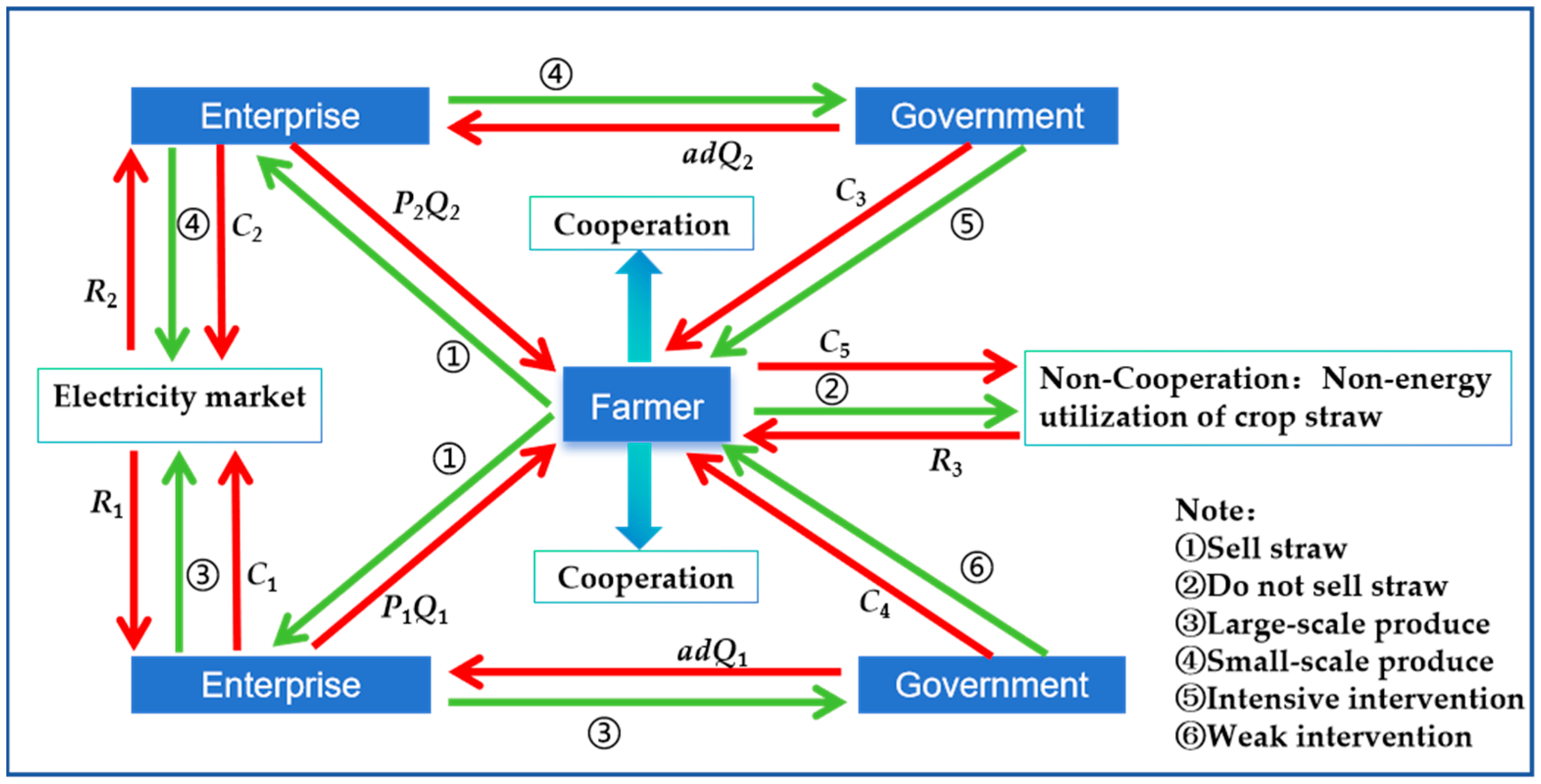
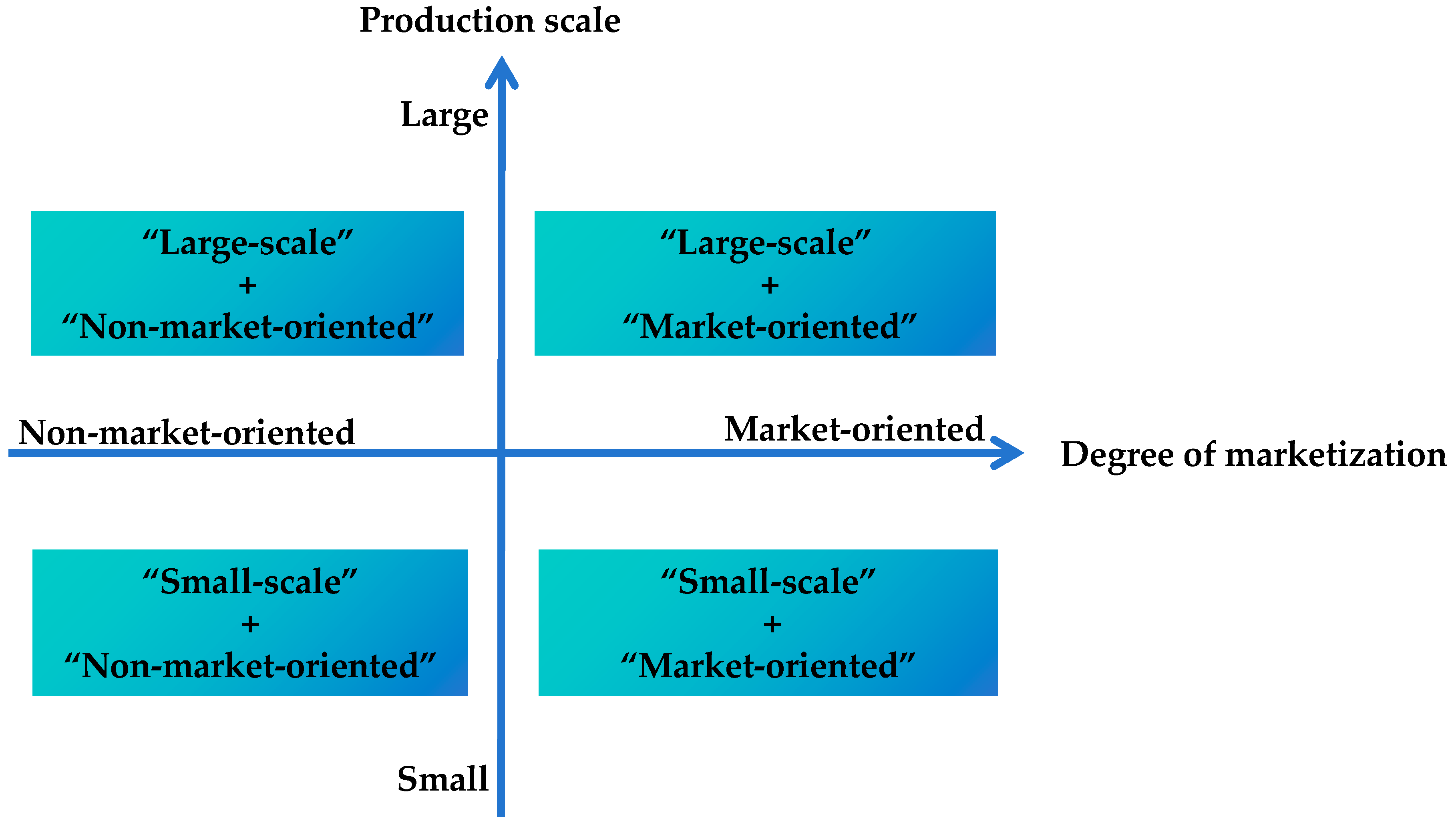
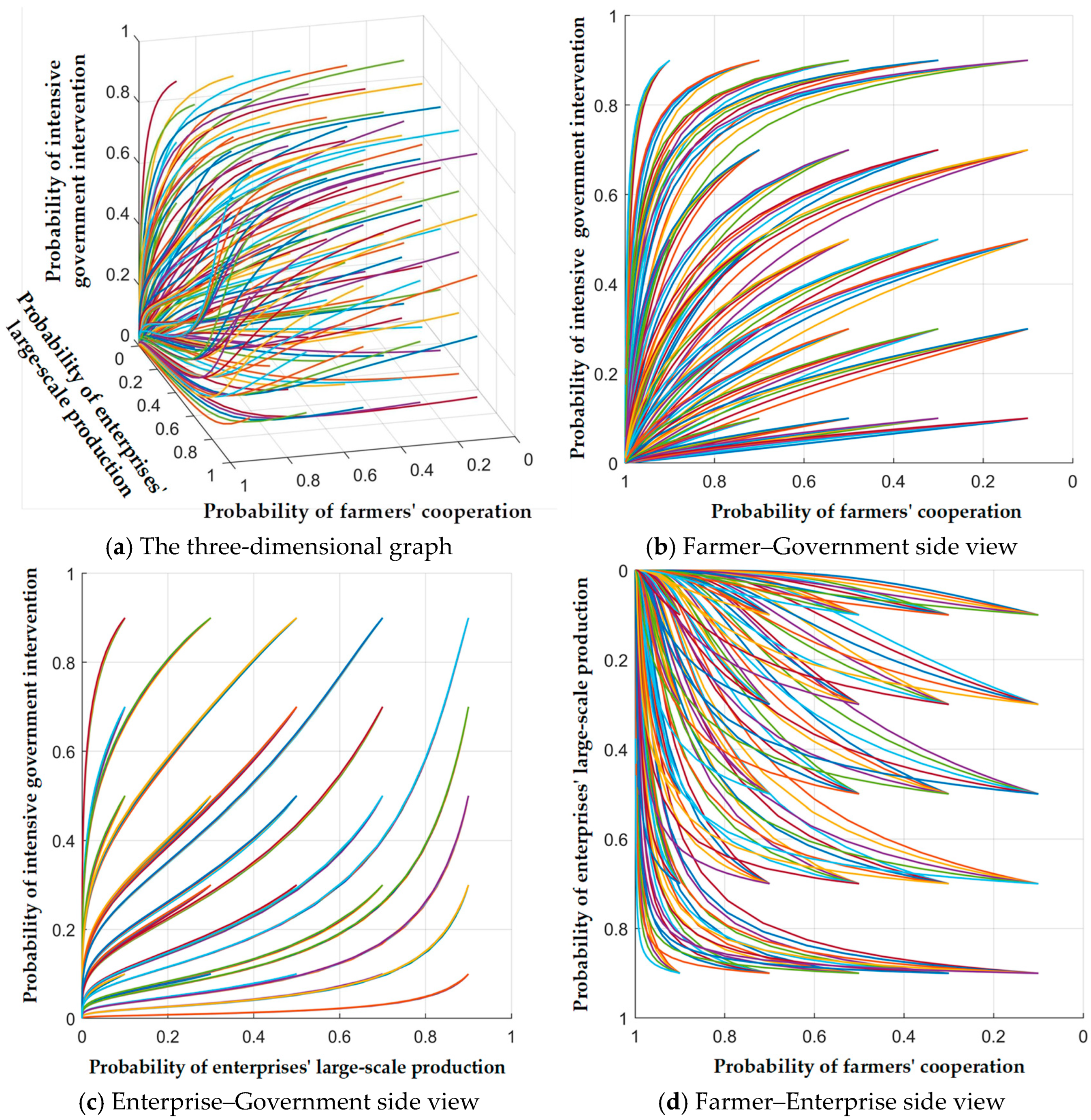

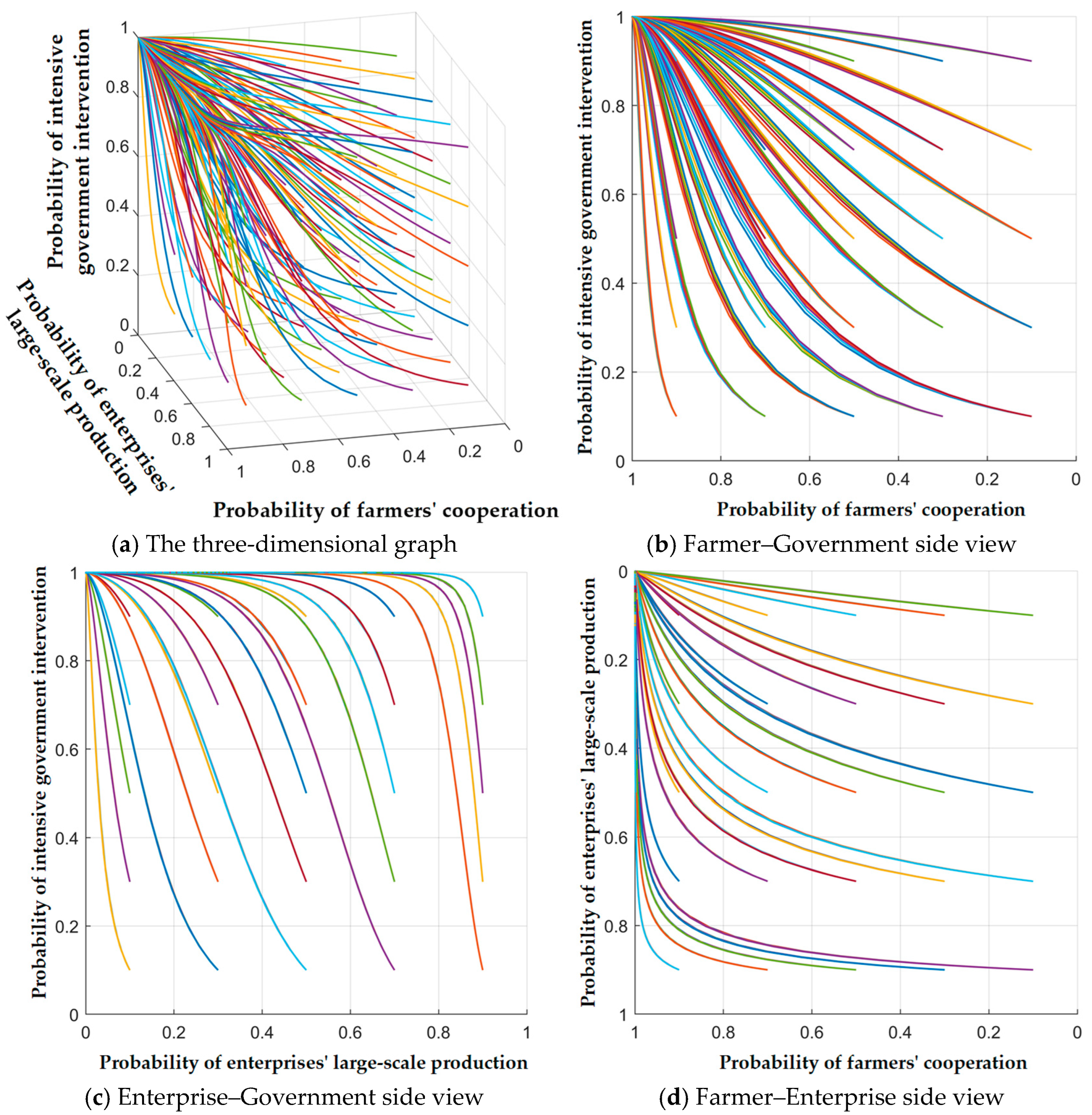
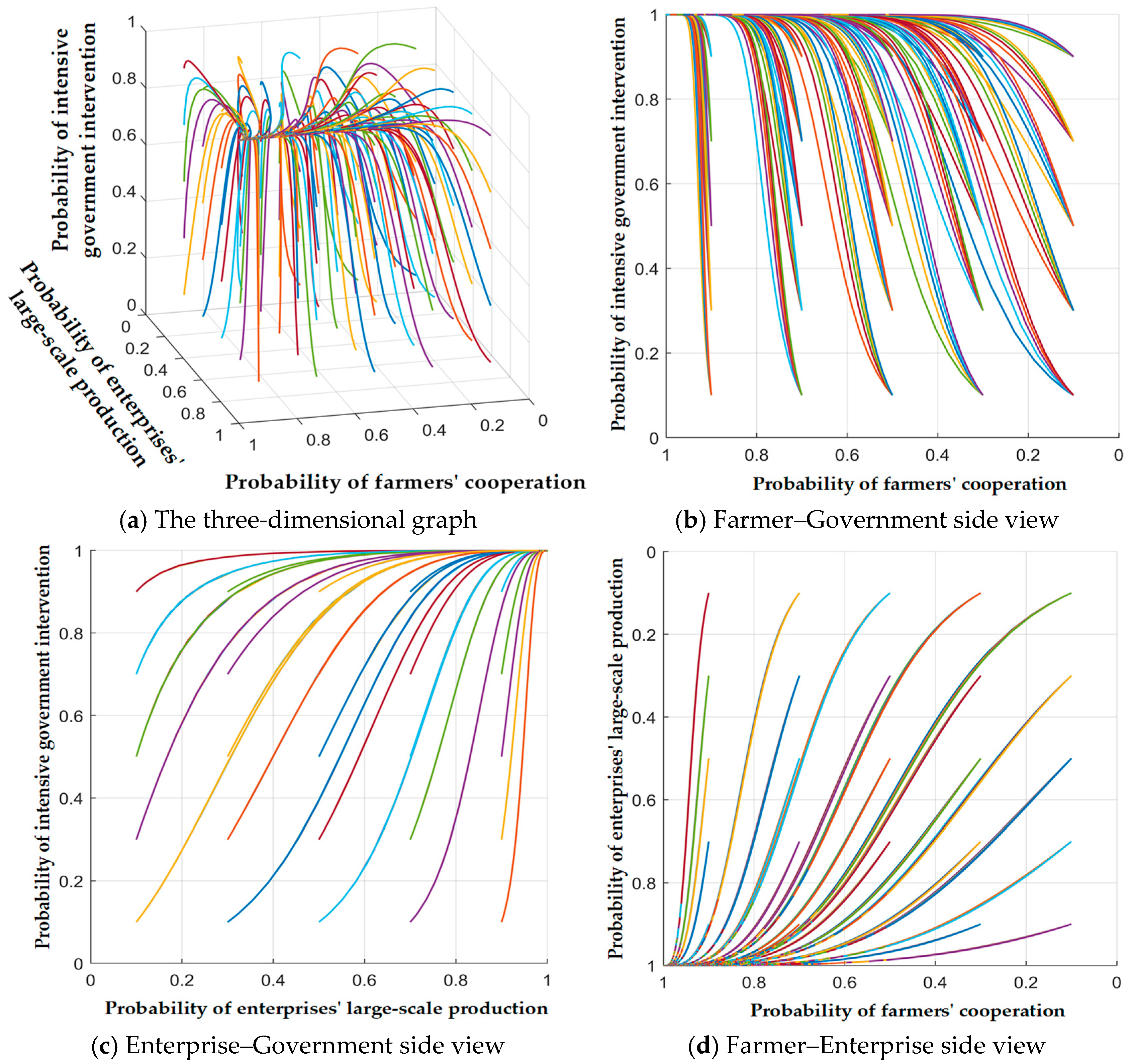
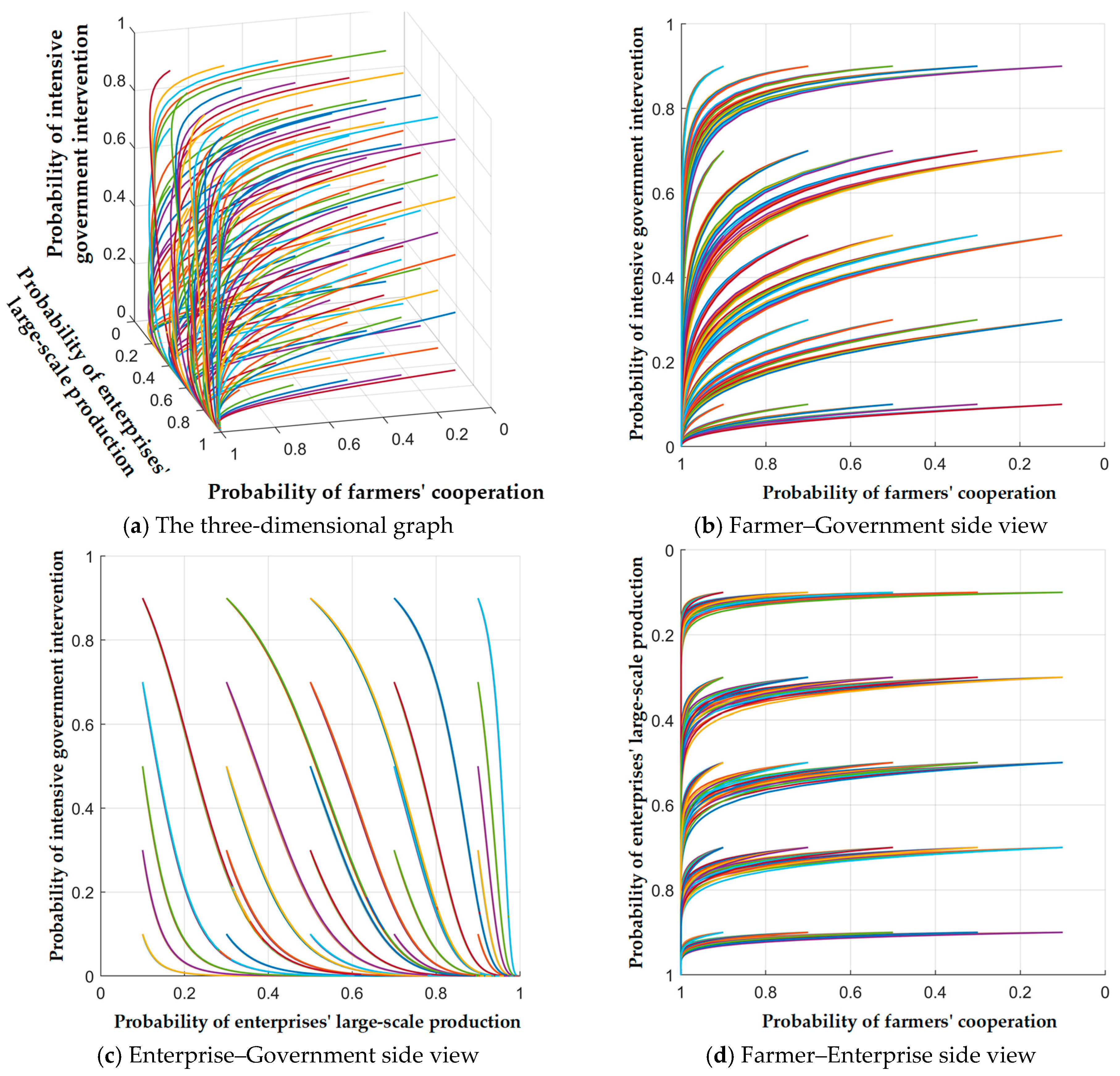
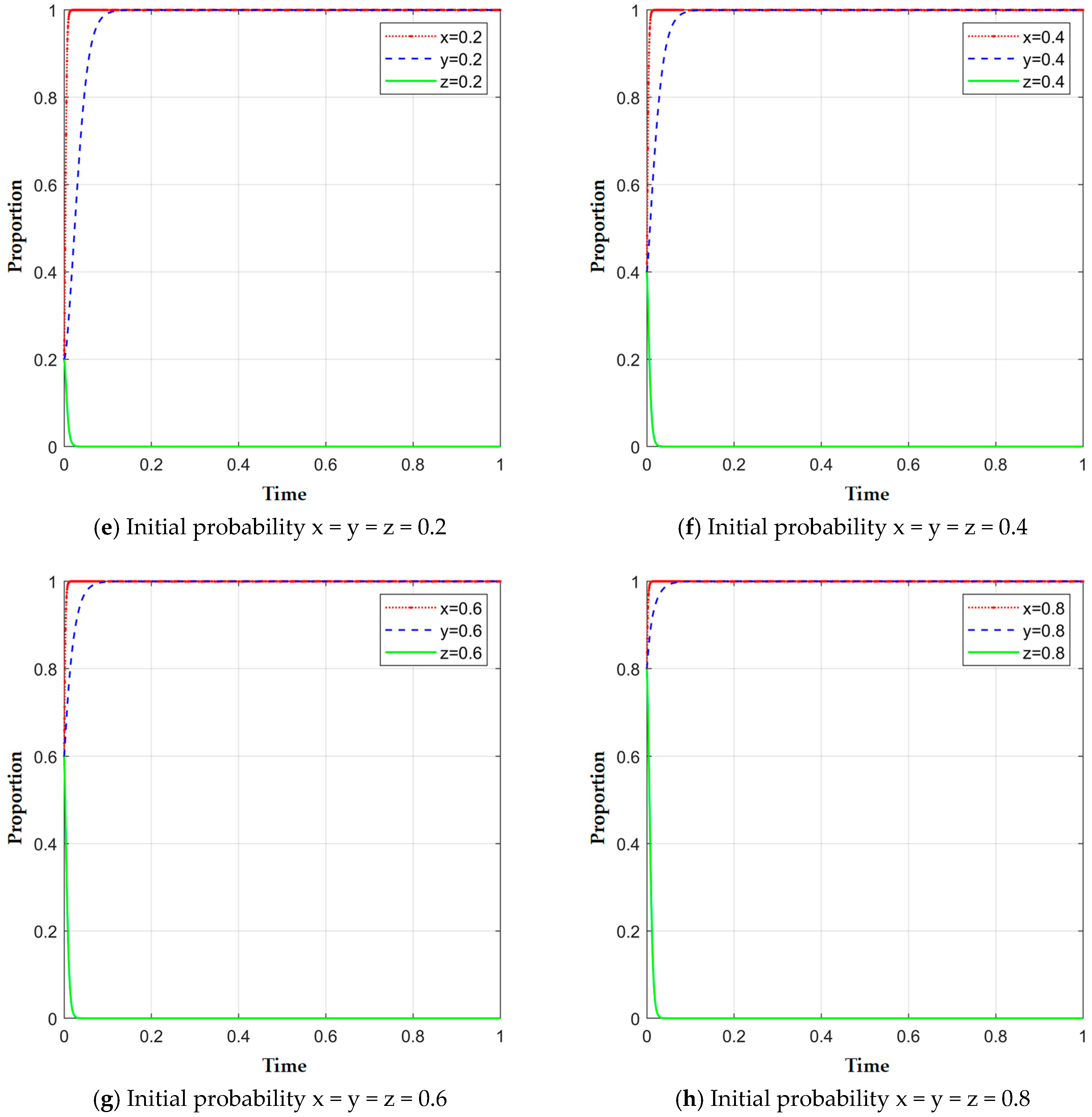
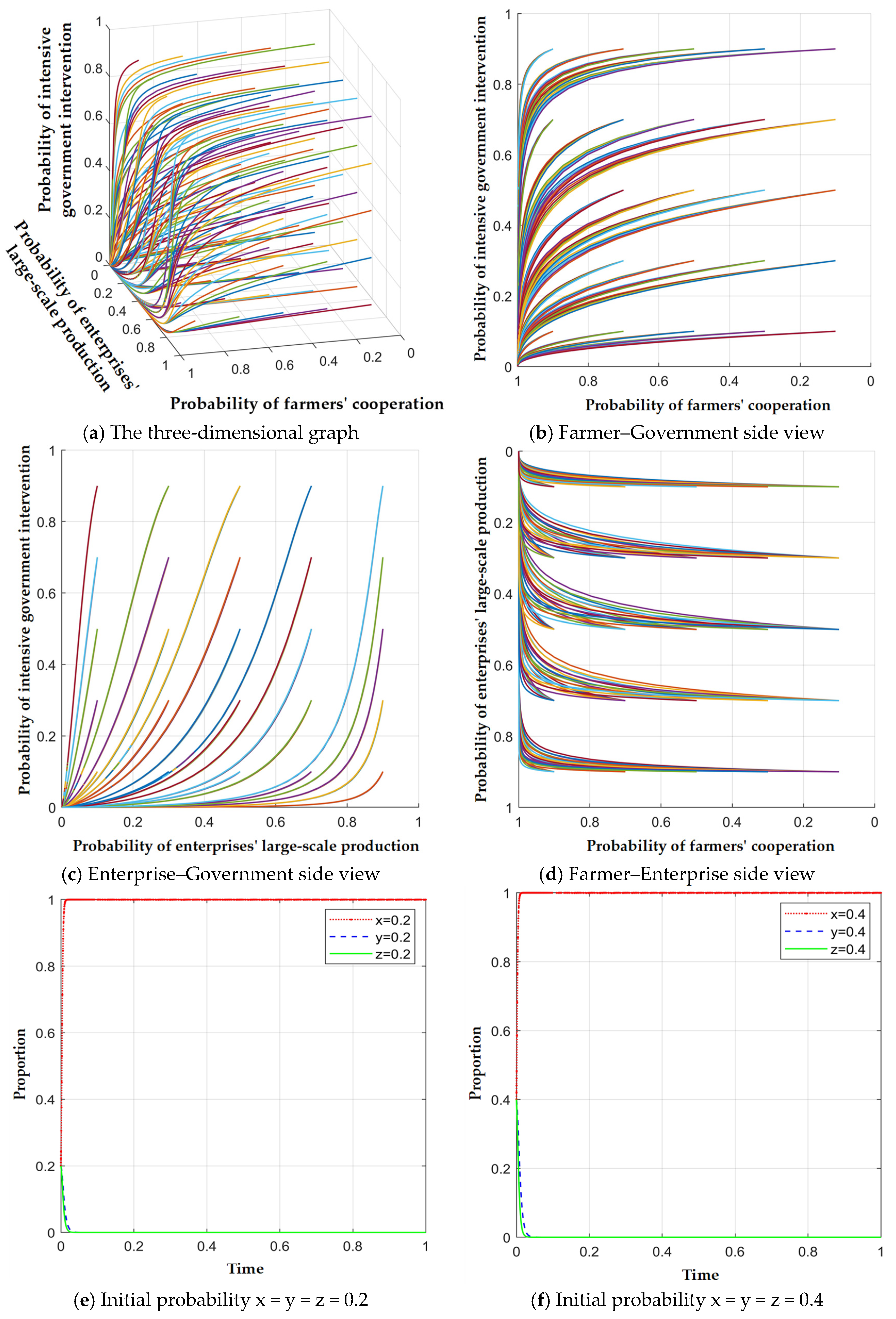
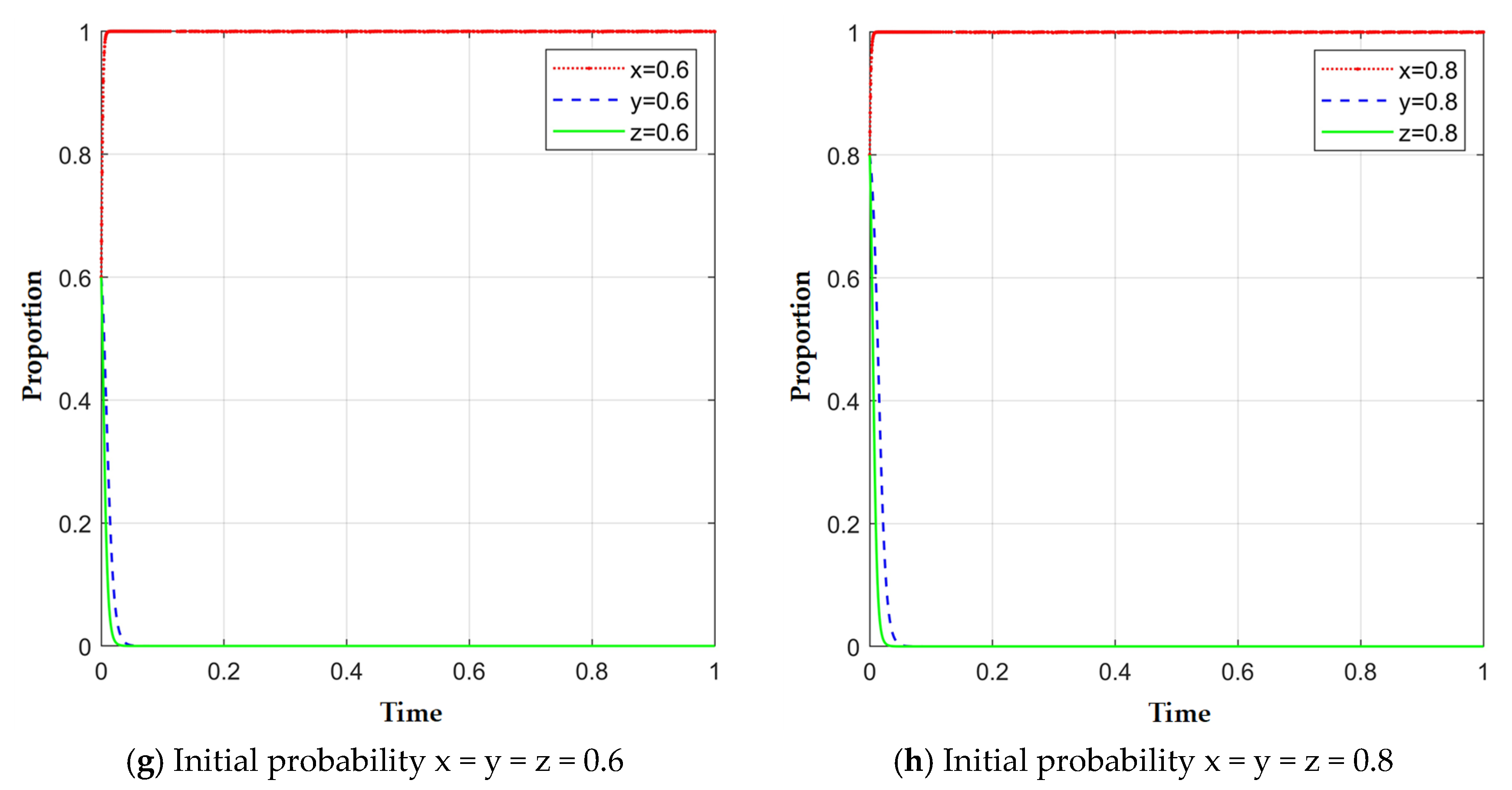
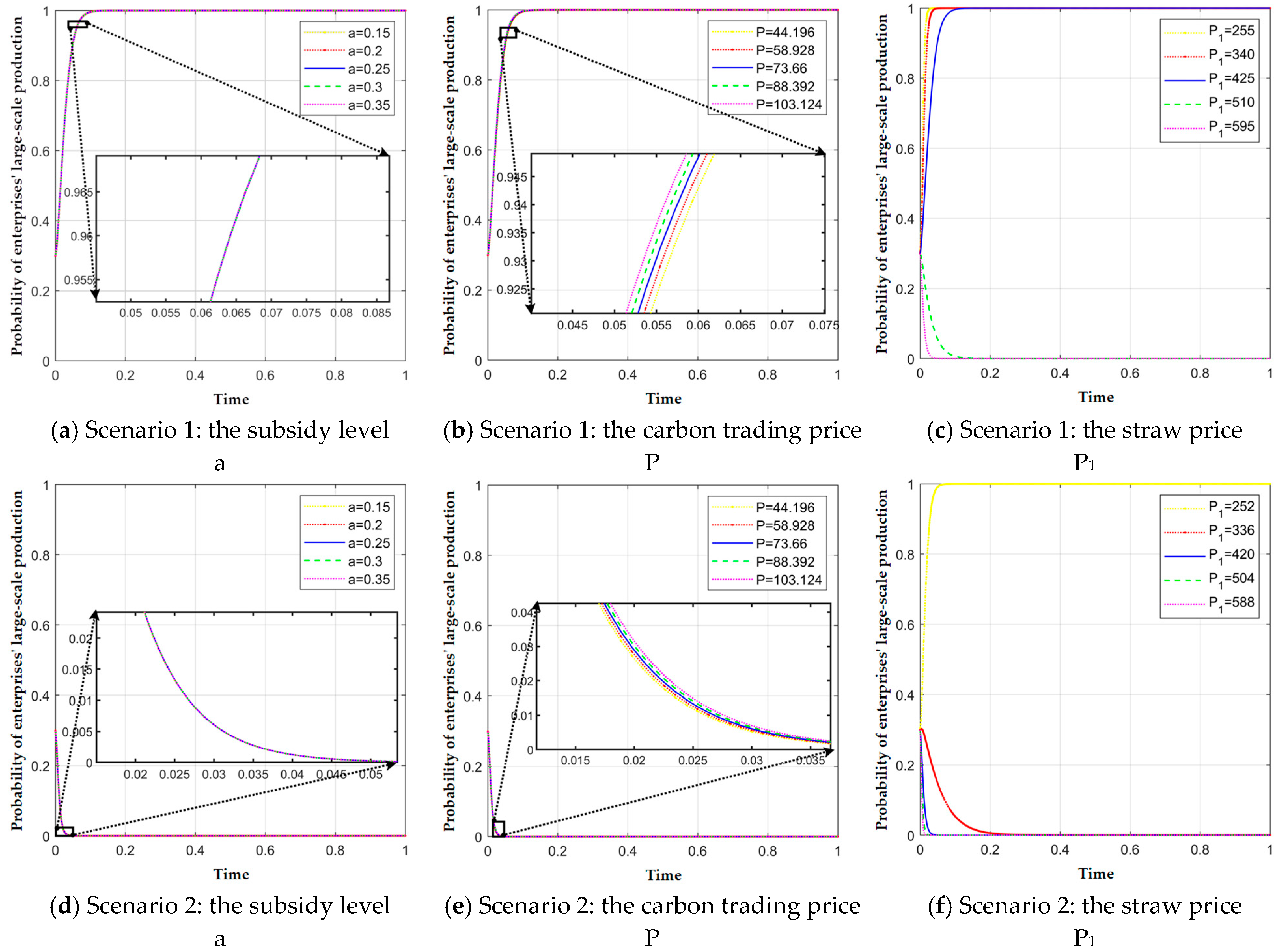
| Variable Name | Definition |
|---|---|
| Electricity revenue from large-scale production, the electricity trading revenue obtained by biomass enterprises when farmers choose the cooperative strategy in large-scale production. | |
| Quantity of straw procured in large-scale production, the amount of straw procured by biomass enterprises when choosing the large-scale production strategy. | |
| Price of straw in large-scale procurement, the price at which biomass enterprises procure straw under the large-scale production strategy. | |
| Large-scale production cost, including equipment purchase, personnel management, straw preprocessing, and transportation costs, excluding straw procurement costs. | |
| Electricity revenue from small-scale production, the electricity trading revenue obtained by biomass enterprises when farmers choose the cooperative strategy in small-scale production. | |
| ) | |
| ) | |
| ) | |
| Cost of intensive government intervention. | |
| Cost of weak government intervention. | |
| Non-cooperative benefit for farmers, specifically the fertilizer savings from self-burning or returning straw to the field. | |
| Labor cost for farmers when handling straw independently. | |
| Fine amount, the administrative penalty imposed by the government on farmers for burning straw under the intensive intervention strategy. | |
| Probability of farmers burning straw. | |
| Carbon reduction coefficient, indicating the net carbon reduction per unit of straw used in biomass power generation. | |
| Carbon trading price. | |
| Straw electricity generation coefficient, indicating the electricity generated per unit of straw. | |
| Subsidy coefficient, the subsidy amount provided by the government to biomass enterprises per unit of electricity generated under the intensive intervention strategy. | |
| Carbon reduction gain coefficient, the additional environmental benefit per unit of carbon reduction (g) under the government’s intensive intervention strategy. | |
| The probability of farmers participating in cooperatives. | |
| The probability of large-scale production by biomass enterprises. | |
| The probability of intensive government intervention. | |
| for non-cooperation. | |
| for small-scale production. | |
| for weak intervention. |
| Strategy Combination | Peasant Payoff | Enterprise Payoff | Government Payoff |
|---|---|---|---|
| 0 | |||
| 0 | |||
| 0 | |||
| 0 |
| Equantequation | Jacobi Matrix Eigenvalues | Stability | ||
|---|---|---|---|---|
| Eigenvalue 1 | Eigenvalue 2 | Eigenvalue 3 | ||
| E1(0, 0, 0) | 0 | instability | ||
| E2(1, 0, 0) | condition ①ESS | |||
| E3(0, 1, 0) | 0 | instability | ||
| E4(0, 0, 1) | 0 | instability | ||
| E5(1, 1, 0) | condition ②ESS | |||
| E6(1, 0, 1) | condition ③ESS | |||
| E7(0, 1, 1) | 0 | instability | ||
| E8(1, 1, 1) | condition ④ESS | |||
| Equantequation | E2 | E5 | E6 | E8 |
|---|---|---|---|---|
| Farmers’ strategy | Cooperation | Cooperation | Cooperation | Cooperation |
| Enterprises’ strategy | Small-scale production | Large-scale production | Small-scale production | Large-scale production |
| Government’s strategy | Weak intervention | Weak intervention | Intensive intervention | Intensive intervention |
| Energy industry scale | Small-scale | Large-scale | Small-scale | Large-scale |
| Features of market | Market-oriented | Market-oriented | Non-market-oriented | Non-market-oriented |
| Policy dependence | Strong | Weak | Invalid | Complete |
| Implications | Improvement of policy intervention and guidance | Maintenance of a healthy environment for industry | Failure of government intervention to require scientific planning and layout of industrial development | Non-sustainable development to require the improvement of the commercialization capability of enterprises |
| Parameter | Numeric Value | Parameter | Numeric Value |
|---|---|---|---|
| 455.7524 | 5 | ||
| 1.2576 | 4.5 | ||
| 425 | 1 | ||
| 195.9743 | 0.0645 | ||
| 379.7952 | 0.3 | ||
| 1.048 | 73.66 | ||
| 500 | 800 | ||
| 189.8976 | 0.25 | ||
| 10 | 20 | ||
| 2 |
| Parameter | Numeric Value | Parameter | Numeric Value |
|---|---|---|---|
| 588.6826 | 5 | ||
| 1.6244 | 4.5 | ||
| 420 | 1 | ||
| 412.0778 | 0.0645 | ||
| 379.7952 | 0.3 | ||
| 1.048 | 73.66 | ||
| 500 | 800 | ||
| 189.8976 | 0.25 | ||
| 10 | 20 | ||
| 2 |
Disclaimer/Publisher’s Note: The statements, opinions and data contained in all publications are solely those of the individual author(s) and contributor(s) and not of MDPI and/or the editor(s). MDPI and/or the editor(s) disclaim responsibility for any injury to people or property resulting from any ideas, methods, instructions or products referred to in the content. |
© 2025 by the authors. Licensee MDPI, Basel, Switzerland. This article is an open access article distributed under the terms and conditions of the Creative Commons Attribution (CC BY) license (https://creativecommons.org/licenses/by/4.0/).
Share and Cite
Yang, Y.; Zhang, L.; Ren, J.; Wang, W.; Sun, X. An Evolutionary Game Perspective for Promoting Utilization of Crop Straw as Energy: A Case Study in Guangdong. Sustainability 2025, 17, 9800. https://doi.org/10.3390/su17219800
Yang Y, Zhang L, Ren J, Wang W, Sun X. An Evolutionary Game Perspective for Promoting Utilization of Crop Straw as Energy: A Case Study in Guangdong. Sustainability. 2025; 17(21):9800. https://doi.org/10.3390/su17219800
Chicago/Turabian StyleYang, Yuexiang, Leixin Zhang, Jiale Ren, Wen Wang, and Xudong Sun. 2025. "An Evolutionary Game Perspective for Promoting Utilization of Crop Straw as Energy: A Case Study in Guangdong" Sustainability 17, no. 21: 9800. https://doi.org/10.3390/su17219800
APA StyleYang, Y., Zhang, L., Ren, J., Wang, W., & Sun, X. (2025). An Evolutionary Game Perspective for Promoting Utilization of Crop Straw as Energy: A Case Study in Guangdong. Sustainability, 17(21), 9800. https://doi.org/10.3390/su17219800






